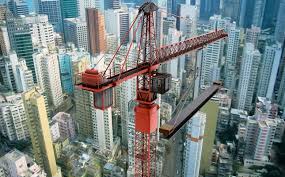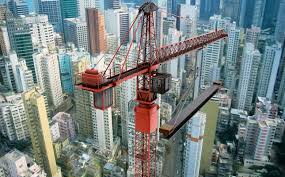
A recent survey by global design and architecture consultancy Arcadis shows that due to the severe shortage of construction labour, Hong Kong is the costliest Asian city to get anything built. The island city is also the world's least affordable urban centre to live and work in.
According to the city's Construction Industry Council website, as of January, there are 427,609 registered construction workers in Hong Kong. And according to data by Hong Kong's Construction Industry Alliance, since 40 per cent of registered workers are older than 50 years, their productivity and number of working days are declining.
While releasing the International Construction Costs Index, Francis Au, Arcadis' country head for Hong Kong and Macau, said that the problem of very high costs of construction is a persistent problem with no apparent and immediate solutions and "the major reason is shortage of labour in Hong Kong."
"Solutions based on migrant labour aren't acceptable to the local population at this stage. To stabilise the rising building costs, the government and the construction industry will have to look into investing in initiatives and solutions that can increase industrial productivity," Francis Au said.
He said that because of the massive number of casinos under construction, Macau is Asia's second-most expensive city for building.
"We used to call those casinos money-printing machines,'" Au said. Going some way to alleviating the labour shortage and cap the costs is the fact that Macau can import construction workers from mainland China and Hong Kong, unlike Hong Kong.
Arcadis said that upcoming mega projects such as the Hong Kong-Zhuhai-Macau bridge, and large housing programmes with 480,000 apartment units expected to be built over the next decade can for the remainder of this year sustain Hong Kong's construction industry workload.
He said that construction costs may be cut by 2 to 3 percentage points, due to slower economic growth in China.
"As China's state economic policy is to expand overseas, we can expect to see more Chinese funds go to other Asian countries such as the Philippines, Malaysia and Cambodia to fuel their infrastructure projects building," he said.
With President Xi Jinping's US$150 billion "One Belt, One Road" signature programme topping the Arcadis survey, North of the border, mainland China will be home to three of the world's 10 priciest infrastructure projects of 2017.
Arcadis said that the world's second-most expensive public works project is India’s US$90 billion New Delhi-Mumbai Industrial Corridor. Rounding off the ninth and 10th positions on the Arcadis survey are the US$13 billion airport extension in Beijing and a US$11 billion airfield in Chengdu.
"Four out of the 10 highest-value construction projects in 2017 are in Asia," said Alan Hearn, Arcadis' head of Asia buildings solutions. "Among them are the "One Belt One Road" initiative and the New Delhi-Mumbai Industrial Corridor. Mega projects like these are mainly funded by public-private partnerships that will continue to fuel the development of the construction industry in Asia."
The Chinese government is relying on infrastructure spending to pump prime demand, generate jobs and spur spending in the world's second-largest economy as the Chinese economy expanding at the slowest pace in almost three decades.
And to enhance and improve the country's creaky telecommunications, transportation and logistics infrastructure to facilitate economic growth, India too is turning on the taps for public works and finally putting resources behind the projects.
(Source:www.cnbc.com)
According to the city's Construction Industry Council website, as of January, there are 427,609 registered construction workers in Hong Kong. And according to data by Hong Kong's Construction Industry Alliance, since 40 per cent of registered workers are older than 50 years, their productivity and number of working days are declining.
While releasing the International Construction Costs Index, Francis Au, Arcadis' country head for Hong Kong and Macau, said that the problem of very high costs of construction is a persistent problem with no apparent and immediate solutions and "the major reason is shortage of labour in Hong Kong."
"Solutions based on migrant labour aren't acceptable to the local population at this stage. To stabilise the rising building costs, the government and the construction industry will have to look into investing in initiatives and solutions that can increase industrial productivity," Francis Au said.
He said that because of the massive number of casinos under construction, Macau is Asia's second-most expensive city for building.
"We used to call those casinos money-printing machines,'" Au said. Going some way to alleviating the labour shortage and cap the costs is the fact that Macau can import construction workers from mainland China and Hong Kong, unlike Hong Kong.
Arcadis said that upcoming mega projects such as the Hong Kong-Zhuhai-Macau bridge, and large housing programmes with 480,000 apartment units expected to be built over the next decade can for the remainder of this year sustain Hong Kong's construction industry workload.
He said that construction costs may be cut by 2 to 3 percentage points, due to slower economic growth in China.
"As China's state economic policy is to expand overseas, we can expect to see more Chinese funds go to other Asian countries such as the Philippines, Malaysia and Cambodia to fuel their infrastructure projects building," he said.
With President Xi Jinping's US$150 billion "One Belt, One Road" signature programme topping the Arcadis survey, North of the border, mainland China will be home to three of the world's 10 priciest infrastructure projects of 2017.
Arcadis said that the world's second-most expensive public works project is India’s US$90 billion New Delhi-Mumbai Industrial Corridor. Rounding off the ninth and 10th positions on the Arcadis survey are the US$13 billion airport extension in Beijing and a US$11 billion airfield in Chengdu.
"Four out of the 10 highest-value construction projects in 2017 are in Asia," said Alan Hearn, Arcadis' head of Asia buildings solutions. "Among them are the "One Belt One Road" initiative and the New Delhi-Mumbai Industrial Corridor. Mega projects like these are mainly funded by public-private partnerships that will continue to fuel the development of the construction industry in Asia."
The Chinese government is relying on infrastructure spending to pump prime demand, generate jobs and spur spending in the world's second-largest economy as the Chinese economy expanding at the slowest pace in almost three decades.
And to enhance and improve the country's creaky telecommunications, transportation and logistics infrastructure to facilitate economic growth, India too is turning on the taps for public works and finally putting resources behind the projects.
(Source:www.cnbc.com)














